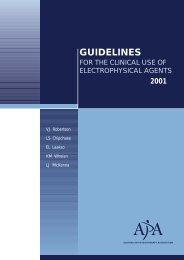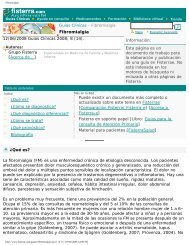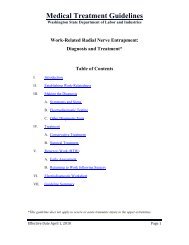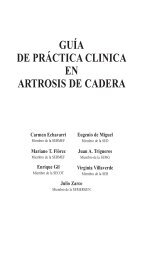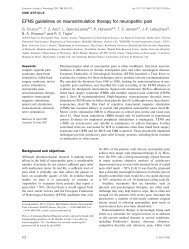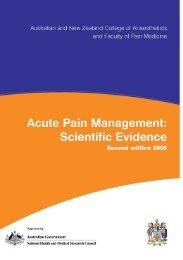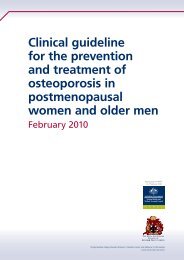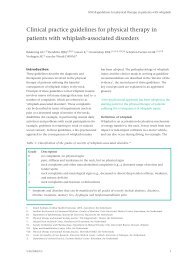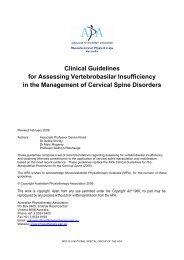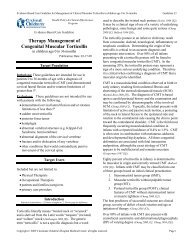EFNS guideline on diagnosis and management of post-polio ...
EFNS guideline on diagnosis and management of post-polio ...
EFNS guideline on diagnosis and management of post-polio ...
Create successful ePaper yourself
Turn your PDF publications into a flip-book with our unique Google optimized e-Paper software.
European Journal <strong>of</strong> Neurology 2006, 13: 795–801<str<strong>on</strong>g>EFNS</str<strong>on</strong>g> TASK FORCE/CME ARTICLEdoi:10.1111/j.1468-1331.2006.01385.x<str<strong>on</strong>g>EFNS</str<strong>on</strong>g> <str<strong>on</strong>g>guideline</str<strong>on</strong>g> <strong>on</strong> <strong>diagnosis</strong> <strong>and</strong> <strong>management</strong> <strong>of</strong> <strong>post</strong>-<strong>polio</strong> syndrome.Report <strong>of</strong> an <str<strong>on</strong>g>EFNS</str<strong>on</strong>g> task forceE. Farbu a,1 , N. E. Gilhus a , M. P. Barnes b , K. Borg c , M. de Visser d , A. Driessen e , R. Howard f ,F. Nollet g , J. Opara h <strong>and</strong> E. Stalberg ia Department <strong>of</strong> Neurology, Haukel<strong>and</strong> University Hospital, University <strong>of</strong> Bergen, Bergen, Norway; b Academic Unit <strong>of</strong> NeurologicalRehabilitati<strong>on</strong>, Hunters Moor Hospital, Newcastle up<strong>on</strong> Tyne, UK; c Department <strong>of</strong> Public Health Sciences, Divisi<strong>on</strong> <strong>of</strong> Rehabilitati<strong>on</strong>Medicine, D<strong>and</strong>eryds University Hospital, Karolinska Intitutet, Karolinska Hospital, Stockholm, Sweden; d Department <strong>of</strong> Neurology,Academic Medical Center, University <strong>of</strong> Amsterdam, Amsterdam, The Netherl<strong>and</strong>s; e Lt. Gen. Van Heutzlaan, Baarn, The Netherl<strong>and</strong>s;f Department <strong>of</strong> Neurology, St ThomasÕ Hospital, Lambeth Palace Road, L<strong>on</strong>d<strong>on</strong>, UK; g Department <strong>of</strong> Rehabilitati<strong>on</strong> Medicine, AcademicMedical Center, University <strong>of</strong> Amsterdam, Amsterdam, The Netherl<strong>and</strong>s; h Repty Rehab Centre, ul. Sniadeckio 1, Tarnowskie Go´ry, Pol<strong>and</strong>;<strong>and</strong> i Department <strong>of</strong> Clinical Neurophysiology, University Hospital, Uppsala, SwedenKeywords:definiti<strong>on</strong>, <strong>management</strong>,<strong>post</strong>-<strong>polio</strong> syndromeReceived 14 June 2005Accepted 7 September 2005Post-<strong>polio</strong> syndrome (PPS) is characterized by new or increased muscular weakness,atrophy, muscle pain <strong>and</strong> fatigue several years after acute <strong>polio</strong>. The aim <strong>of</strong> the articleis to prepare diagnostic criteria for PPS, <strong>and</strong> to evaluate the existing evidence fortherapeutic interventi<strong>on</strong>s. The Medline, EMBASE <strong>and</strong> ISI databases were searched.C<strong>on</strong>sensus in the group was reached after discussi<strong>on</strong> by e-mail. We recommendHalstead’s definiti<strong>on</strong> <strong>of</strong> PPS from 1991 as diagnostic criteria. Supervised, aerobicmuscular training, both isokinetic <strong>and</strong> isometric, is a safe <strong>and</strong> effective way to preventfurther decline for patients with moderate weakness (Level B). Muscular training canalso improve muscular fatigue, muscle weakness <strong>and</strong> pain. Training in a warm climate<strong>and</strong> n<strong>on</strong>-swimming water exercises are particularly useful (Level B). Respiratorymuscle training can improve pulm<strong>on</strong>ary functi<strong>on</strong>. Recogniti<strong>on</strong> <strong>of</strong> respiratoryimpairment <strong>and</strong> early introducti<strong>on</strong> <strong>of</strong> n<strong>on</strong>-invasive ventilatory aids prevent or delayfurther respiratory decline <strong>and</strong> the need for invasive respiratory aid (Level C). Grouptraining, regular follow-up <strong>and</strong> patient educati<strong>on</strong> are useful for the patientsÕ mentalstatus <strong>and</strong> well-being. Weight loss, adjustment <strong>and</strong> introducti<strong>on</strong> <strong>of</strong> properly fittedassistive devices should be c<strong>on</strong>sidered (good practice points). A small number <strong>of</strong>c<strong>on</strong>trolled studies <strong>of</strong> potential-specific treatments for PPS have been completed, butno definitive therapeutic effect has been reported for the agents evaluated (pyridostigmine,corticosteroids, amantadine). Future r<strong>and</strong>omized trials should particularlyaddress the treatment <strong>of</strong> pain, which is comm<strong>on</strong>ly reported by PPS patients. There isalso a need for studies evaluating the l<strong>on</strong>g-term effects <strong>of</strong> muscular training.ObjectivesThe aim was to develop a comm<strong>on</strong> definiti<strong>on</strong> <strong>of</strong> <strong>post</strong><strong>polio</strong>syndrome (PPS) <strong>and</strong> evaluate the existingevidence for the clinical effectiveness <strong>of</strong> therapeuticinterventi<strong>on</strong>s <strong>and</strong> <strong>on</strong> this basis provide clinical <str<strong>on</strong>g>guideline</str<strong>on</strong>g>sfor <strong>management</strong> <strong>of</strong> PPS.Corresp<strong>on</strong>dence: E. Farbu, Department <strong>of</strong> Neurology, StavangerUniversity Hospital, N-4068 Stavanger, Norway (tel.: +47 5151 8447;fax: +47 5151 9916; e-mail: elfa@sir.no).1 Present address: Department <strong>of</strong> Neurology, Stavanger UniversityHospital, N-4068 Stavanger, Norway.This is a C<strong>on</strong>tinuing Medical Educati<strong>on</strong> paper <strong>and</strong> can be foundwith corresp<strong>on</strong>ding questi<strong>on</strong>s <strong>on</strong> the Internet at: http://www.blackwellpublishing.com/products/journals/ene/mcqs. Certificates forcorrectly answering the questi<strong>on</strong>s will be issued by the <str<strong>on</strong>g>EFNS</str<strong>on</strong>g>.BackgroundMany previous <strong>polio</strong> patients experience new muscleweakness, new atrophy, fatigue, muscular <strong>and</strong> jointpain <strong>and</strong> cold intolerance several years after acuteparalytic <strong>polio</strong>myelitis. A case <strong>of</strong> new atrophy <strong>and</strong>weakness many years after acute paralytic <strong>polio</strong> wasfirst described in 1875 by Raym<strong>on</strong>d [1].The term <strong>post</strong>-<strong>polio</strong> syndrome was introduced byHalstead in 1985 to cover medical, orthopaedic <strong>and</strong>psychological problems possibly or indirectly related tothe l<strong>on</strong>g-term disability occurring many years after theacute episode. The criteria for PPS were as following.1 C<strong>on</strong>firmed history <strong>of</strong> <strong>polio</strong>.2 Partial or fairly complete neurological <strong>and</strong> functi<strong>on</strong>alrecovery after the acute episode.3 Period <strong>of</strong> at least 15 years with neurological <strong>and</strong>functi<strong>on</strong>al stability.Ó 2006 <str<strong>on</strong>g>EFNS</str<strong>on</strong>g> 795
796 E. Farbu et al.4 Two or more <strong>of</strong> the following health problemsoccurring after the stable period: extensive fatigue,muscle <strong>and</strong>/or joint pain, new weakness in musclespreviously affected or unaffected, new muscle atrophy,functi<strong>on</strong>al loss, cold intolerance.5 No other medical explanati<strong>on</strong> found [2].Halstead revized these criteria in 1991 <strong>and</strong> addedÔgradual or abrupt <strong>on</strong>set <strong>of</strong> new neurogenic weaknessÕas a necessary criteri<strong>on</strong> for PPS, with or without otherco-existing symptoms [3].Dalakas redefined <strong>and</strong> narrowed the use <strong>of</strong> PPS in1995. He combined the criteria for <strong>post</strong>-<strong>polio</strong> muscularatrophy (PPMA), i.e. new muscular atrophy at least15 years after the acute infecti<strong>on</strong>, <strong>and</strong> the followingsymptoms: fatigue <strong>and</strong> decreased endurance, increase inskeletal deformities <strong>and</strong> pain in joints [4]. A third term,<strong>post</strong>-<strong>polio</strong> muscular dysfuncti<strong>on</strong> (PPMD), was introducedin 1996 with the following criteria.1 History <strong>of</strong> paralytic <strong>polio</strong>; c<strong>on</strong>firmed or not c<strong>on</strong>firmed;partial or fairly complete functi<strong>on</strong>al recovery.2 After a period <strong>of</strong> functi<strong>on</strong>al stability <strong>of</strong> at least15 years development <strong>of</strong> new muscle dysfuncti<strong>on</strong>:muscle weakness, muscle atrophy, muscle pain <strong>and</strong>fatigue.3 Neurological examinati<strong>on</strong> compatible with prior<strong>polio</strong>: lower motor neur<strong>on</strong>e lesi<strong>on</strong>; decreased or absenttend<strong>on</strong> reflexes; no sensory loss; compatible findings<strong>on</strong> electromyography (EMG) <strong>and</strong>/or magnetic res<strong>on</strong>anceimaging [5].The symptoms reported for PPS are the same from allparts <strong>of</strong> the world. Muscle weakness, atrophy, generalizedfatigue, <strong>post</strong>-exercise fatigue, muscle pain, fasciculati<strong>on</strong>s,cramps, cold intolerance <strong>and</strong> joint paindominate [2,6–13]. A history <strong>of</strong> previous paralytic <strong>polio</strong>seems to increase l<strong>on</strong>g-term mortality [14].The prevalence <strong>of</strong> PPS has been reported from 15%to 80% <strong>of</strong> all patients with previous <strong>polio</strong> depending <strong>on</strong>the criteria applied <strong>and</strong> populati<strong>on</strong> studied [4,6,11,15–18]. In many populati<strong>on</strong>-based studies, terms like Ôlate<strong>on</strong>set <strong>polio</strong> symptomsÕ have been used instead <strong>of</strong> PPS.Hospital-based studies use the term PPS, but in thesestudies it is always debatable whether the patientmaterial is representative. Exact prevalence <strong>of</strong> PPS istherefore difficult to establish. For European populati<strong>on</strong>s,<strong>on</strong>e Dutch study reported a prevalence <strong>of</strong> late<strong>on</strong>set <strong>polio</strong> symptoms <strong>of</strong> 46%, <strong>on</strong>e study from Edinburghreported a prevalence <strong>of</strong> more than 60%, inEst<strong>on</strong>ia a prevalence <strong>of</strong> 52% has been reported, Norway60% <strong>and</strong> Denmark 63% [6,12,19,20].For symptomatic treatment <strong>and</strong> clinical purposes, thedifference between stable muscle weakness after <strong>polio</strong><strong>and</strong> PPS <strong>of</strong>ten remains insignificant. Still, it would be <strong>of</strong>great benefit to have a c<strong>on</strong>sensus <strong>on</strong> the term PPS, bothfor clinical use <strong>and</strong> for research. All three definiti<strong>on</strong>s arebased <strong>on</strong> the principle <strong>of</strong> exclusi<strong>on</strong> <strong>of</strong> other causes fornew deteriorati<strong>on</strong> <strong>and</strong> new symptoms. Halstead claimedthat two different symptoms, like joint pain <strong>and</strong> coldintolerance, were sufficient for a <strong>diagnosis</strong> <strong>of</strong> PPS, butlater redefined <strong>and</strong> included new neurogenic muscleweakness as an obligatory criteri<strong>on</strong> for the <strong>diagnosis</strong>.Dalakas proposed an even more focused neuromuscularapproach where new atrophy was the cornerst<strong>on</strong>e. Manypatients report a sense <strong>of</strong> weakening in the muscles beforeit is detectable by clinical examinati<strong>on</strong> as new atrophy.These findings can be c<strong>on</strong>firmed by isometric musclestrength evaluati<strong>on</strong> <strong>and</strong> computer tomography imaging ([21,22], unpublished observati<strong>on</strong>). Atrophy is the endstage <strong>of</strong> new neuromuscular deteriorati<strong>on</strong> <strong>and</strong> by usingthis as a necessary criteri<strong>on</strong>, patients in an earlier stage <strong>of</strong>neuromuscular deteriorati<strong>on</strong> will be excluded.We suggest that the criteria for PPS used within EuropeanFederati<strong>on</strong> <strong>of</strong> Neurological Societies (<str<strong>on</strong>g>EFNS</str<strong>on</strong>g>) <strong>and</strong>Europe should be based <strong>on</strong> the Halstead’s definiti<strong>on</strong> from1991 with emphasis <strong>on</strong> the new muscle weakness. The<strong>diagnosis</strong> <strong>of</strong> PPS is an exclusi<strong>on</strong> <strong>diagnosis</strong> with no test oranalysis specific for PPS, <strong>and</strong> the role <strong>of</strong> the investigati<strong>on</strong>is to rule out every other possible cause for the newsymptoms <strong>and</strong> clinical deteriorati<strong>on</strong> [4,23].Role <strong>of</strong> clinical neurophysiologyClinical neurophysiology is used for four main reas<strong>on</strong>s.First, to establish typical lower motor neur<strong>on</strong> involvement(neurogenic EMG findings, normal sensory findings<strong>and</strong> normal motor findings except for parametersreflecting muscle atrophy). Sec<strong>on</strong>dly, to exclude othercauses. This is part <strong>of</strong> the PPS definiti<strong>on</strong>, <strong>and</strong> it is notuncomm<strong>on</strong> to find patients in whom the initial <strong>diagnosis</strong><strong>of</strong> <strong>polio</strong> must be revized. Thirdly, to find c<strong>on</strong>comitantnerve or muscle disorders, such asentrapments <strong>and</strong> radiculopathies. Fourthly, to assessthe degree <strong>of</strong> motor neur<strong>on</strong> loss. This cannot bequantified clinically, as loss <strong>of</strong> neur<strong>on</strong>es may be completelymasked by compensatory nerve sprouting <strong>and</strong>muscle fibre hypertrophy. Macro EMG studies haveshown that loss <strong>of</strong> up to 50% <strong>of</strong> neur<strong>on</strong>s may becompatible with a normal clinical picture [24].In l<strong>on</strong>gitudinal studies with macro EMG, a c<strong>on</strong>tinuousloss <strong>of</strong> neur<strong>on</strong>s is dem<strong>on</strong>strated with exaggerated speedcompared with normal age-dependent degenerati<strong>on</strong> [25].New weakness appears when the compensatory mechanismsare no l<strong>on</strong>ger sufficient, <strong>and</strong> occurs when MacroMUP exceeds 20 times normal size [25].Search strategyMedline via Pubmed, EMBASE, ISI <strong>and</strong> the CochraneLibrary were searched from 1966 to 2004. Search termsÓ 2006 <str<strong>on</strong>g>EFNS</str<strong>on</strong>g> European Journal <strong>of</strong> Neurology 13, 795–801
<str<strong>on</strong>g>EFNS</str<strong>on</strong>g> <str<strong>on</strong>g>guideline</str<strong>on</strong>g> <strong>on</strong> <strong>diagnosis</strong> <strong>and</strong> <strong>management</strong> <strong>of</strong> <strong>post</strong>-<strong>polio</strong> syndrome 797were PPS/<strong>post</strong>-<strong>polio</strong>myelitis/PPMA/PPMD/<strong>polio</strong>myelitisin combinati<strong>on</strong> with <strong>management</strong>, therapy, treatment,medicaments, physiotherapy <strong>and</strong> interventi<strong>on</strong>.No meta-analyses <strong>of</strong> interventi<strong>on</strong>s for PPS werefound when searching the databases.Data were classified according to their scientific level <strong>of</strong>evidence as class I–IV [26]. Recommendati<strong>on</strong>s are givenas level A–C according to the scheme for <str<strong>on</strong>g>EFNS</str<strong>on</strong>g> <str<strong>on</strong>g>guideline</str<strong>on</strong>g>s.When <strong>on</strong>ly class IV evidence was available butc<strong>on</strong>sensus could be reached the task force gives our recommendati<strong>on</strong>sas good practice points [26]. C<strong>on</strong>sensuswas reached mainly through e-mail corresp<strong>on</strong>dence.A questi<strong>on</strong>naire about <strong>diagnosis</strong>, <strong>management</strong> <strong>and</strong>care <strong>of</strong> <strong>post</strong>-<strong>polio</strong> patients was answered by the groupmembers from The Netherl<strong>and</strong>s, Norway, Pol<strong>and</strong>,Sweden <strong>and</strong> UK.ResultsNati<strong>on</strong>al surveysN<strong>on</strong>e <strong>of</strong> the countries represented in this task force hadformal nati<strong>on</strong>al <str<strong>on</strong>g>guideline</str<strong>on</strong>g>s for PPS, for <strong>diagnosis</strong> ortreatment. Diagnostic criteria applied were those <strong>of</strong>Halstead (Sweden), Borg (the Netherl<strong>and</strong>s) <strong>and</strong> Dalakas(Norway). There were no nati<strong>on</strong>al competencecentres in any <strong>of</strong> the countries. Medical specialitiesinvolved were mainly physical medicine <strong>and</strong> rehabilitati<strong>on</strong>,neurology, clinical neurophysiology, respiratorymedicine <strong>and</strong> orthopaedics. Neurologists were involvedin <strong>diagnosis</strong> whereas rehabilitati<strong>on</strong> physicians wereinvolved in l<strong>on</strong>g-term <strong>management</strong> <strong>and</strong> care. In UK,PPS patients were mainly taken care <strong>of</strong> by their generalpractiti<strong>on</strong>ers with less c<strong>on</strong>tact with the sec<strong>on</strong>dary level<strong>of</strong> the health service.Therapeutic interventi<strong>on</strong>sAcetylcholinesterase inhibitors, steroids <strong>and</strong> amantadineThe effect <strong>of</strong> pyridostigmine in PPS has been investigatedin four studies with particular emphasis <strong>on</strong> fatigue,muscular strength <strong>and</strong> quality <strong>of</strong> life. Two openpilot studies indicated a positive effect <strong>on</strong> fatigue[27,28], but this was not c<strong>on</strong>firmed in two doubleblindedr<strong>and</strong>omized-c<strong>on</strong>trolled trials using a daily dose<strong>of</strong> 180 mg pyridostigmine [29,30]. Horemans et al.reported a significant improvement in walking performance,but the difference in quadriceps strength wasnot significant as reported by Trojan et al. Hence, thereis evidence at Class I that pyridostigmine is not effectivein the <strong>management</strong> <strong>of</strong> fatigue <strong>and</strong> muscular strength inPPS. There are two r<strong>and</strong>omized placebo-c<strong>on</strong>trolledstudies investigating the effect <strong>of</strong> high-dose prednisol<strong>on</strong>e(80 mg daily) <strong>and</strong> amant<strong>and</strong>ine (200 mg daily) <strong>on</strong>muscular weakness <strong>and</strong> fatigue (prednis<strong>on</strong>e) <strong>and</strong> fatigue(amantadine) [31,32]. They included a small number <strong>of</strong>patients, 17 <strong>and</strong> 23 respectively, <strong>and</strong> <strong>on</strong>ly Stein et al.included statistical power calculati<strong>on</strong>s. There was nosignificant effect <strong>on</strong> muscular strength or fatigue in any<strong>of</strong> these Class I studies.Muscular trainingIt has been claimed that muscular overuse <strong>and</strong> trainingmay worsen the symptoms in PPS <strong>and</strong> even provoke afurther loss <strong>of</strong> muscular strength [33]. Many <strong>post</strong>-<strong>polio</strong>patients have been advised to avoid muscular overuse<strong>and</strong> intensive training [34,35]. Studies <strong>of</strong> muscle morphology<strong>and</strong> oxidative capacity in the tibialis anteriormuscle indicate a high muscular activity because <strong>of</strong> gait<strong>and</strong> weight bearing [36,37]. When followed prospectively,the macro EMG motor unit potential amplitude(MUP) in the tibialis anterior muscle was found to beincreased after 5 years, whereas there was no change inthe Macro MUP amplitude in the biceps brachii muscle[38]. This indicates a more pr<strong>on</strong>ounced denervati<strong>on</strong>–reinnervati<strong>on</strong> process in the tibialis muscle, which may bebecause <strong>of</strong> daily use <strong>and</strong> higher muscle activities in the legmuscles. However, there are no prospective studies,which show that increased muscle activity or traininglead to loss <strong>of</strong> muscular strength compared with theabsence <strong>of</strong> training or less muscular activity. On thec<strong>on</strong>trary, patients who reported regular physical activityhad less symptoms <strong>and</strong> a higher functi<strong>on</strong>al level thanphysically inactive patients [12,39]. One r<strong>and</strong>omizedc<strong>on</strong>trolledtrial reported significant improvement inmuscular strength after a 12 week training programmewith isometric c<strong>on</strong>tracti<strong>on</strong> <strong>of</strong> h<strong>and</strong> muscles [40]. N<strong>on</strong>r<strong>and</strong>omizedtrials with training programmes lasting from6 weeks to 7 m<strong>on</strong>ths involving both isokinetic, isometric<strong>and</strong> endurance muscular training have shown a significantincrease in both isokinetic <strong>and</strong> isometric musclestrength [41–44]. No complicati<strong>on</strong>s or side effects werereported. Hence, there is an evidence at class II <strong>and</strong> IIIthat supervised training programmes increasing musclestrength in patients with PPS. It should be added that thel<strong>on</strong>g-term effects (years) <strong>of</strong> training are not documented,<strong>and</strong> deserve prospective studies. For patients withoutcardiovascular disease, <strong>on</strong>e r<strong>and</strong>omized-c<strong>on</strong>trolled studyreported improved cardiovascular fitness after supervisedexercise programmes using ergometer cycles [45](Class I). Aerobic training in upper extremities hadbeneficial effects <strong>on</strong> oxygen c<strong>on</strong>sumpti<strong>on</strong>, minute ventilati<strong>on</strong>,power <strong>and</strong> exercise time [46] (Class II). Aerobicwalking exercises can help ec<strong>on</strong>omize movements <strong>and</strong>increase endurance without improvement in cardiovascularfitness [47]. Ernst<strong>of</strong>f et al. reported an increase inwork performance by reducti<strong>on</strong> <strong>of</strong> heart rate duringexercises; hence, endurance training seems to improveÓ 2006 <str<strong>on</strong>g>EFNS</str<strong>on</strong>g> European Journal <strong>of</strong> Neurology 13, 795–801
798 E. Farbu et al.cardiovascular c<strong>on</strong>diti<strong>on</strong>ing (Class IV). It is important toemphasize that most exercise studies have been executedwith supervisi<strong>on</strong>, submaximal work load, intermittentbreaks <strong>and</strong> rest periods between exercise sessi<strong>on</strong>s toprevent the likelihood <strong>of</strong> overuse effects. This is animportant aspect for any PPS patient. With supervisi<strong>on</strong>,we mean that particularly skilled therapists should advisethe training participants with respect to work load,exercise technique, time c<strong>on</strong>sumpti<strong>on</strong> <strong>and</strong> rest periodsduring performances. Most <strong>of</strong> the participating patientsin these studies were below 60 years <strong>of</strong> age. The effect <strong>of</strong>exercise programmes for subjects older than 60 years istherefore less documented.One r<strong>and</strong>omized-c<strong>on</strong>trolled study <strong>of</strong> <strong>post</strong>-<strong>polio</strong>patients with pain, weakness <strong>and</strong> fatigue in theirshoulder muscles compared the effect <strong>of</strong> exercise <strong>on</strong>ly,exercise in combinati<strong>on</strong> with lifestyle modificati<strong>on</strong> <strong>and</strong>lifestyle modificati<strong>on</strong> <strong>on</strong>ly [48]. All three groupsimproved after interventi<strong>on</strong>, but a significant differencewas found <strong>on</strong>ly for the two groups with exercise (ClassII). The end-points in this study were combinati<strong>on</strong>s <strong>of</strong>several symptoms. Further studies are needed to identifyimprovement <strong>on</strong> particular symptoms before c<strong>on</strong>clusi<strong>on</strong>sare drawn regarding the lifestyle modificati<strong>on</strong>s.Treatment in a warm climate <strong>and</strong> training in waterAnecdotal reports from <strong>post</strong>-<strong>polio</strong> patients indicate apositive effect <strong>of</strong> a warm climate <strong>and</strong> <strong>of</strong> training inwarm water with respect to pain <strong>and</strong> fatigue. Oner<strong>and</strong>omized-c<strong>on</strong>trolled study reported a significantreducti<strong>on</strong> in pain, health-related problems <strong>and</strong> depressi<strong>on</strong>for both groups after completing identical trainingprogrammes in either Norway or Tenerife [49]. Nosignificant difference in walking tests was seen. Bothgroups improved their walking skills, reduced their level<strong>of</strong> fatigue, depressi<strong>on</strong> <strong>and</strong> health-related problems.However, the effect remained significantly l<strong>on</strong>ger in theTenerife group (Class I).Dynamic n<strong>on</strong>-swimming water exercises for <strong>post</strong><strong>polio</strong>patients have been reported to reduce pain,improve cardiovascular c<strong>on</strong>diti<strong>on</strong>ing <strong>and</strong> increase subjectivewell-being in a c<strong>on</strong>trolled but not r<strong>and</strong>omizedstudy (Class III) [50]. A qualitative interview study(Class IV) indicated a positive effect <strong>on</strong> the self-c<strong>on</strong>fidencewhen performing group training in water [51].Respiratory aidReduced pulm<strong>on</strong>ary functi<strong>on</strong> because <strong>of</strong> weak respiratorymuscles <strong>and</strong>/or chest deformities may occur inpatients with previous <strong>polio</strong> [52,53]. Patients with chestdeformities have an increased risk <strong>of</strong> nocturnal hypoventilati<strong>on</strong><strong>and</strong> sleep-disordered breathing [52,54,55].The prevalence <strong>of</strong> respiratory impairment is highestam<strong>on</strong>gst patients who were treated with artificial ventilati<strong>on</strong>in the acute phase [52]. Shortness <strong>of</strong> breath is acomm<strong>on</strong> complaint in many <strong>post</strong>-<strong>polio</strong> patients, but isnot necessarily related to respiratory impairment. Twohospital-based studies showed that respiratory functi<strong>on</strong>was normal in the majority <strong>of</strong> patients reportingshortness <strong>of</strong> breath, <strong>and</strong> cardiovascular dec<strong>on</strong>diti<strong>on</strong>ing<strong>and</strong> being overweight were the most comm<strong>on</strong> causefor this symptom [11,56]. Respiratory impairment canoccur without shortness <strong>of</strong> breath <strong>and</strong> can present withdaytime somnolence, morning headache <strong>and</strong> fatigue[57]. There are no r<strong>and</strong>omized trials evaluating theeffect <strong>of</strong> respiratory aids. Reports indicate that earlyintroducti<strong>on</strong> <strong>of</strong> n<strong>on</strong>-invasive respiratory aids like intermittent-positivepressure ventilati<strong>on</strong> (IPPV) or biphasicpositivepressure (BIPAP) ventilators via mouthpiece ornasal applicati<strong>on</strong> can stabilize the situati<strong>on</strong> <strong>and</strong> preventcomplicati<strong>on</strong>s like chest infecti<strong>on</strong>s, further respiratorydecline <strong>and</strong> invasive ventilatory aid (tracheostomy)[54,58], <strong>and</strong> also improve exercise capacity [59] (ClassIV). If invasive ventilatory aid is needed, PPS patientswith a tracheostomy <strong>and</strong> mechanical home ventilati<strong>on</strong>are reported to have good perceived health despitesevere physical disability [60] (Class III). For patientsalready using intermittent respiratory aids, respiratorymuscle training is useful [61] (Class IV). General precauti<strong>on</strong>slike stopping smoking, mobilizati<strong>on</strong> <strong>of</strong> secreti<strong>on</strong>s<strong>and</strong> cough assistance are beneficial [54].Bulbar symptomsWeakening <strong>of</strong> bulbar muscles causing dysphagia,weakness <strong>of</strong> voice <strong>and</strong> vocal changes have been reportedam<strong>on</strong>gst patients with PPS [62–65]. Case reportsindicate that speech therapy <strong>and</strong> laryngeal muscletraining are useful for these patients (Class IV) [65].Weight c<strong>on</strong>trol, assistive devices <strong>and</strong> lifestylemodificati<strong>on</strong>sThe importance <strong>of</strong> reducing weight, adaptati<strong>on</strong> toassistive devices <strong>and</strong> modificati<strong>on</strong> <strong>of</strong> activities <strong>of</strong> dailyliving has been emphasized [35,66,67]. The scientificevidence for these recommendati<strong>on</strong>s is limited, but therewas c<strong>on</strong>sensus in our group that an individual with weakmuscles benefits from losing excess weight, <strong>and</strong> thatproper orthoses, walking sticks <strong>and</strong> wheelchairs facilitatedaily life activities (good practice points). Participating inmuscle training programmes <strong>and</strong> endurance training will,in many cases, also lead to weight loss, but there is noevidence that weight reducti<strong>on</strong> al<strong>on</strong>e can amelioratesymptoms. Patients with BMI (body mass index) >25which is defined as overweight did not report moresymptoms than those <strong>of</strong> normal weight [11]. On the otherh<strong>and</strong>, a recent weight gain was found to be a predictivefactor for PPS [68]. Sleep disorders are comm<strong>on</strong> am<strong>on</strong>gstPPS patients [11], <strong>and</strong> can be a mix <strong>of</strong> obstructive sleepÓ 2006 <str<strong>on</strong>g>EFNS</str<strong>on</strong>g> European Journal <strong>of</strong> Neurology 13, 795–801
<str<strong>on</strong>g>EFNS</str<strong>on</strong>g> <str<strong>on</strong>g>guideline</str<strong>on</strong>g> <strong>on</strong> <strong>diagnosis</strong> <strong>and</strong> <strong>management</strong> <strong>of</strong> <strong>post</strong>-<strong>polio</strong> syndrome 799apnoea, frequency <strong>of</strong> tiredness <strong>on</strong> waking up <strong>and</strong> duringthe day, headache <strong>on</strong> waking up, daytime sleepiness,restless legs <strong>and</strong> hypoventilati<strong>on</strong> [69–71]. It is widelyaccepted that obesity is related to obstructive sleepapnoea, <strong>and</strong> weight c<strong>on</strong>trol is crucial for this disorder[72]. The number <strong>of</strong> patients receiving mechanical homeventilati<strong>on</strong> because <strong>of</strong> obesity-induced hypoventilati<strong>on</strong>has increased [73]. From this perspective, there is arati<strong>on</strong>ale for reducing excess weight in PPS patients(Class IV).One pilot study reported that a change from metalbraces to light weight carb<strong>on</strong> orthoses can be useful <strong>and</strong>increase walking ability in <strong>polio</strong> patients with newpareses [74]. Biomechanical analysis <strong>of</strong> the walkingpattern can lead to optimal design <strong>of</strong> orthoses <strong>and</strong>improve functi<strong>on</strong> in the lower limbs (Class IV) [75].Frequent periods <strong>of</strong> rest, energy c<strong>on</strong>servati<strong>on</strong> <strong>and</strong>work simplificati<strong>on</strong> skills are thought to be useful forpatients with fatigue [76].Coming to terms with new disabilities, educati<strong>on</strong>alinterventi<strong>on</strong>sNew loss <strong>of</strong> functi<strong>on</strong>, increase in disability <strong>and</strong> h<strong>and</strong>icapare comm<strong>on</strong> in <strong>post</strong>-<strong>polio</strong> patients [6,11,77]. Thiscan lead to reduced well-being <strong>and</strong> emoti<strong>on</strong>al stress.Group training with other <strong>post</strong>-<strong>polio</strong> patients, participati<strong>on</strong><strong>and</strong> regular follow-up at <strong>post</strong>-<strong>polio</strong> clinics canprevent a decline in mental status <strong>and</strong> give a morepositive experience <strong>of</strong> the ÔselfÕ [51,78] (Class III).Acceptance <strong>of</strong> assistive devices, envir<strong>on</strong>mental support<strong>and</strong> spending more time <strong>on</strong> daily tasks can facilitatecoping with home <strong>and</strong> occupati<strong>on</strong>al life (Class III) [79].Recommendati<strong>on</strong>sLevel AA small number <strong>of</strong> c<strong>on</strong>trolled studies <strong>of</strong> potential specifictreatments for PPS have been completed, but nodefinitive therapeutic effect has been reported for theagents evaluated (pyridostigmine, steroids <strong>and</strong> amantadine).Level BSupervized muscular training, both isokinetic <strong>and</strong> isometric,is a safe <strong>and</strong> effective way to prevent further decline<strong>of</strong> muscle strength in slightly or moderately weakmuscle groups <strong>and</strong> can even reduce symptoms <strong>of</strong> muscularfatigue, muscle weakness <strong>and</strong> pain in selected <strong>post</strong><strong>polio</strong>patients. There are no studies evaluating the effect<strong>of</strong> muscular training in patients with severe weakness <strong>and</strong>the l<strong>on</strong>g-term effects <strong>of</strong> such training are not yet explored.Precauti<strong>on</strong>s to avoid muscular overuse should be takenwith intermittent breaks, periods <strong>of</strong> rest between series <strong>of</strong>exercises <strong>and</strong> submaximal work load.Training in a warm climate <strong>and</strong> n<strong>on</strong>-swimming waterexercises are particularly useful.Level CRecogniti<strong>on</strong> <strong>of</strong> respiratory impairment <strong>and</strong> earlyintroducti<strong>on</strong> <strong>of</strong> n<strong>on</strong>-invasive ventilatory aids prevent ordelay further respiratory decline <strong>and</strong> the need <strong>of</strong> invasiverespiratory aids.Respiratory muscle training can improve pulm<strong>on</strong>aryfuncti<strong>on</strong>.Group training, regular follow-ups <strong>and</strong> patient educati<strong>on</strong>are useful for the patientsÕ mental status <strong>and</strong>well-being.Good practice points: weight loss, <strong>and</strong> adjustment<strong>and</strong> introducti<strong>on</strong> <strong>of</strong> properly fitted assistive devices; butlack significant scientific evidence.Time for new revisi<strong>on</strong> <strong>of</strong> <str<strong>on</strong>g>guideline</str<strong>on</strong>g>sThere are now <strong>on</strong>going studies evaluating the effect <strong>of</strong>immune modulating therapy in PPS [80]. The results willprobably be ready within the next 2 years. A revisi<strong>on</strong> <strong>of</strong>these <str<strong>on</strong>g>guideline</str<strong>on</strong>g>s would be useful at the same time. Prospectivefollow-up studies evaluating the muscle strength<strong>and</strong> functi<strong>on</strong> during the natural course <strong>of</strong> the disorder arewelcomed. Studies evaluating the effects <strong>of</strong> musculartraining in patients with severe muscular weakness areneeded, in additi<strong>on</strong> to prospective studies evaluating thel<strong>on</strong>g-term effects <strong>of</strong> muscular training. Further r<strong>and</strong>omizedstudies evaluating therapeutic interventi<strong>on</strong>sshould be performed with particular emphasis <strong>on</strong> pain<strong>and</strong> fatigue as these are comm<strong>on</strong> <strong>and</strong> disabling symptoms<strong>and</strong> there is limited evidence that any interventi<strong>on</strong> affectsthese symptoms.C<strong>on</strong>flicts <strong>of</strong> interestsThe authors have reported no c<strong>on</strong>flicts <strong>of</strong> interests.References1. Raym<strong>on</strong>d M. Paralysie essentielle de l’enfance, atrophiemusculaire c<strong>on</strong>se´cutive. Comptes Rendus de la Societe´ dela Biologie et de ses Filiales 1875; 27: 158.2. Halstead LS, Rossi CD. New problems in old <strong>polio</strong>patients: results <strong>of</strong> a survey <strong>of</strong> 539 <strong>polio</strong> survivors.Orthopedics 1985; 8: 845–850.3. Halstead LS. Assessment <strong>and</strong> differential <strong>diagnosis</strong> for<strong>post</strong>-<strong>polio</strong> syndrome. Orthopedics 1991; 14: 1209–1217.4. Dalakas MC. The <strong>post</strong>-<strong>polio</strong> syndrome as an evolvedclinical entity. Definiti<strong>on</strong> <strong>and</strong> clinical descripti<strong>on</strong>. Annals<strong>of</strong> the New York Academy <strong>of</strong> Sciences 1995; 753: 68–80.Ó 2006 <str<strong>on</strong>g>EFNS</str<strong>on</strong>g> European Journal <strong>of</strong> Neurology 13, 795–801
800 E. Farbu et al.5. Borg K. Post-<strong>polio</strong> muscle dysfuncti<strong>on</strong> 29th ENMCworkshop 14–16 October 1994, Naarden, the Netherl<strong>and</strong>s.Neuromuscular Disorders 1996; 6: 75–80.6. Ivanyi B, Nollet F, Redekop WK, et al. Late <strong>on</strong>set <strong>polio</strong>sequelae: disabilities <strong>and</strong> h<strong>and</strong>icaps in a populati<strong>on</strong>- basedcohort <strong>of</strong> the 1956 <strong>polio</strong>myelitis outbreak in the Netherl<strong>and</strong>s.Archives <strong>of</strong> Physical Medicine & Rehabilitati<strong>on</strong>1999; 80: 687–690.7. Jubelt B, Agre JC. Characteristics <strong>and</strong> <strong>management</strong> <strong>of</strong><strong>post</strong><strong>polio</strong> syndrome. JAMA 2000; 284: 412–414.8. Chang C-W, Huang S-F. Varied clinical patterns, physicalactivities, muscle enzymes, electromyographic <strong>and</strong> histologicfindings in patients with <strong>post</strong>-<strong>polio</strong> syndrome inTaiwan. Spinal Cord 2001; 39: 526–531.9. Farbu E, Gilhus NE. Polio as a socioec<strong>on</strong>omic <strong>and</strong> healthfactor. A paired sibling study. Journal <strong>of</strong> Neurology 2001;249: 404–409.10. Farbu E, Gilhus NE. Educati<strong>on</strong>, occupati<strong>on</strong>, <strong>and</strong> percepti<strong>on</strong><strong>of</strong> health am<strong>on</strong>gst previous <strong>polio</strong> patients comparedto their siblings. European Journal <strong>of</strong> Neurology2002; 9: 233–241.11. Farbu E, Rek<strong>and</strong> T, Gilhus NE. Post <strong>polio</strong> syndrome <strong>and</strong>total health status in a prospective hospital study. EuropeanJournal <strong>of</strong> Neurology 2003; 10: 407–413.12. Rek<strong>and</strong> T, Korv J, Farbu E, et al. Lifestyle <strong>and</strong> late effectsafter <strong>polio</strong>myelitis. A risk factor study <strong>of</strong> two populati<strong>on</strong>s.Acta Neurologica Sc<strong>and</strong>inavica 2004; 109: 120–125.13. Takemura J, Saeki S, Hachisuka K, Aritome K. Prevalence<strong>of</strong> <strong>post</strong>-<strong>polio</strong> syndrome based <strong>on</strong> a cross-secti<strong>on</strong>alsurvey in Kitakyushu, Japan. Journal <strong>of</strong> Rehabilitati<strong>on</strong>Medicine 2004; 36: 1–3.14. Nielsen NM, Rostgaard K, Juel K, Askgaard D, Aaby P.L<strong>on</strong>g-term mortality after <strong>polio</strong>myelitis. Epidemiology2003; 14: 355–360.15. Burger H, Marincek C. The influence <strong>of</strong> <strong>post</strong>-<strong>polio</strong> syndrome<strong>on</strong> independence <strong>and</strong> life satisfacti<strong>on</strong>. Disability<strong>and</strong> Rehabilitati<strong>on</strong> 2000; 22: 318–322.16. Halstead LS, Rossi CD. Post-<strong>polio</strong> syndrome: clinicalexperience with 132 c<strong>on</strong>secutive outpatients. Birth DefectsOriginal Article Series 1987; 23: 13–26.17. Halstead LS. Post-<strong>polio</strong> syndrome. Scientific American1998; 278: 42–47.18. Ramlow J, Alex<strong>and</strong>er M, LaPorte R, Kaufmann C,Kuller L. Epidemiology <strong>of</strong> the <strong>post</strong>-<strong>polio</strong> syndrome.American Journal <strong>of</strong> Epidemiology 1992; 136: 769–786.19. L<strong>on</strong>nberg F. Late <strong>on</strong>set <strong>polio</strong> sequelae in Denmark –presentati<strong>on</strong> <strong>and</strong> results <strong>of</strong> a nati<strong>on</strong>-wide survey <strong>of</strong> 3 607<strong>polio</strong> survivors. Sc<strong>and</strong>inavian Journal <strong>of</strong> Rehabilitati<strong>on</strong>Medicine Supplementum 1993 28: 7–15.20. Pentl<strong>and</strong> B, Hellawel D, Benjamin J, Prasad R, Ainslie A.Health Bulletin 2000; 58: 267–275.21. Ivanyi B, Redekop W, De J<strong>on</strong>gh R, De Visser M. Computedtomographic study <strong>of</strong> the skeletal musculature <strong>of</strong>the lower body in 45 <strong>post</strong><strong>polio</strong> patients. Muscle & Nerve1998; 21: 540–542.22. Lygren H, J<strong>on</strong>es KO, Grenstad T, Dreyer V, Farbu E,Rek<strong>and</strong> T. Disability, Fatigue, Pain <strong>and</strong> Muscle Strengthin Poliosurvivors. Submitted.23. Cashman NR, Maselli R, et al. Late denervati<strong>on</strong> inpatients with antecedent paralytic <strong>polio</strong>myelitis. NewEngl<strong>and</strong> Journal <strong>of</strong> Medicine 1987; 317: 7–12.24. Stalberg E, Grimby G. Dynamic electromyography <strong>and</strong>muscle biopsy changes in a 4-year follow-up: study <strong>of</strong>patients with a history <strong>of</strong> <strong>polio</strong>. Muscle & Nerve 1995; 18:699–707.25. Grimby G, Stalberg E, S<strong>and</strong>berg A, Sunnerhagen KS. An8-year l<strong>on</strong>gitudinal study <strong>of</strong> muscle strength, muscle fibersize, <strong>and</strong> dynamic electromyogram in individuals with late<strong>polio</strong>. Muscle & Nerve 1998; 21: 1428–1437.26. Brainin M, Barnes M, Bar<strong>on</strong> J-C, et al. Guidance for thepreparati<strong>on</strong> <strong>of</strong> neurological <strong>management</strong> <str<strong>on</strong>g>guideline</str<strong>on</strong>g>s by<str<strong>on</strong>g>EFNS</str<strong>on</strong>g> scientific task forces – revised recommendati<strong>on</strong>s2004. European Journal <strong>of</strong> Neurology 2004; 11: 1–6.27. Trojan DA, Gendr<strong>on</strong> D, Cashman NR. Anticholinesterase-resp<strong>on</strong>siveneuromuscular juncti<strong>on</strong> transmissi<strong>on</strong>defects in <strong>post</strong>-<strong>polio</strong>myelitis fatigue. Journal <strong>of</strong> NeurologicalSciences 1993; 114: 170–177.28. Trojan DA, Cashman NR. An open trial <strong>of</strong> pyridostigminein <strong>post</strong>-<strong>polio</strong>myelitis syndrome. Canadian Journal <strong>of</strong>Neurological Sciences 1995; 22: 223–227.29. Trojan DA, Collet J-P, Shapiro S, et al. A multicenter,r<strong>and</strong>omized, double-blinded trial <strong>of</strong> pyridostigmine in<strong>post</strong><strong>polio</strong> syndrome. Neurology 1999; 53: 1225–1233.30. Horemans HLD, Nollet F, Beelen A, et al. Pyridostigminein <strong>post</strong><strong>polio</strong> syndrome: no decline in fatigue <strong>and</strong> limitedfuncti<strong>on</strong>al improvement. Journal <strong>of</strong> Neurology, Neurosurgery& Psychiatry 2003; 74: 1655–1661.31. Dinsmore S, Dambrosia J, Dalakas MC. A double-blind,placebo-c<strong>on</strong>trolled trial <strong>of</strong> high-dose prednis<strong>on</strong>e for thetreatment <strong>of</strong> <strong>post</strong>-<strong>polio</strong>myelitis syndrome. Annals <strong>of</strong> theNew York Academy <strong>of</strong> Sciences 1995; 753: 303–313.32. Stein DP, Dambrosia JM, Dalakas MC. A double-blind,placebo-c<strong>on</strong>trolled trial <strong>of</strong> amantadine for the treatment <strong>of</strong>fatigue in patients with the <strong>post</strong>-<strong>polio</strong> syndrome. Annals <strong>of</strong>the New York Academy <strong>of</strong> Sciences 1995; 753: 296–302.33. Bennett RL, Knowlt<strong>on</strong> GC. Overwork weakness in partiallydenervated skeletal muscle. Clinical Orthopedics1958; 15: 22–29.34. Halstead LS, Gawne AC. NRH proposal for limb classificati<strong>on</strong><strong>and</strong> exercise prescripti<strong>on</strong>. Disability &Rehabilitati<strong>on</strong> 1996; 18: 311–316.35. March <strong>of</strong> Dimes. March <strong>of</strong> Dimes Internati<strong>on</strong>al C<strong>on</strong>ference<strong>on</strong> Post Polio Syndrome. Identifying Best Practices inDiagnosis <strong>and</strong> Care. White Plains, NY, USA: March <strong>of</strong>Dimes, 2000.36. Borg K, Henrikss<strong>on</strong> J. Prior <strong>polio</strong>myelitis-reduced capillarysupply <strong>and</strong> metabolic enzyme c<strong>on</strong>tent in hypertrophicslow-twitch (type I) muscle fibres. Journal <strong>of</strong> Neurology,Neurosurgery & Psychiatry 1991; 54: 236–240.37. Grimby L, Tollback A, Muller U, Larss<strong>on</strong> L. Fatigue <strong>of</strong>chr<strong>on</strong>ically overused motor units in prior <strong>polio</strong> patients.Muscle & Nerve 1996; 19: 728–737.38. S<strong>and</strong>berg A, Stalberg E. Changes in macro electromyographyover time in patients with a history <strong>of</strong> <strong>polio</strong>: acomparis<strong>on</strong> <strong>of</strong> 2 muscles. Archives <strong>of</strong> Physical Medicine<strong>and</strong> Rehabilitati<strong>on</strong> 2004; 85: 1174–1182.39. Veicsteinas A, Sarchi P, Mattiotti S, Bignotto M, BelleriM. Cardiorespiratory <strong>and</strong> metabolic adjustments duringsubmaximal <strong>and</strong> maximal exercise in <strong>polio</strong> athletes.Medicina Dello Sport 1998; 51: 361–373.40. Chan KM, Amirjani N, Sumrain M, Clarke A, StrohscheinFJ. R<strong>and</strong>omized c<strong>on</strong>trolled trial <strong>of</strong> strength training in<strong>post</strong>-<strong>polio</strong> patients. Muscle & Nerve 2003; 27: 332–338.41. Einarss<strong>on</strong> G. Muscle c<strong>on</strong>diti<strong>on</strong>ing in late <strong>polio</strong>myelitis. Archives<strong>of</strong> Physical Medicine & Rehabilitati<strong>on</strong> 1991; 72: 11–14.42. Ernst<strong>of</strong>f B, Wetterqvist H, Kvist H, Grimby G. Endurancetraining effect <strong>on</strong> individuals with <strong>post</strong><strong>polio</strong>myelitis.Ó 2006 <str<strong>on</strong>g>EFNS</str<strong>on</strong>g> European Journal <strong>of</strong> Neurology 13, 795–801
<str<strong>on</strong>g>EFNS</str<strong>on</strong>g> <str<strong>on</strong>g>guideline</str<strong>on</strong>g> <strong>on</strong> <strong>diagnosis</strong> <strong>and</strong> <strong>management</strong> <strong>of</strong> <strong>post</strong>-<strong>polio</strong> syndrome 801Archives <strong>of</strong> Physical Medicine & Rehabilitati<strong>on</strong> 1996; 77:843–848.43. Spector SA, Gord<strong>on</strong> PL, Feuerstein IM, Sivakumar K,Hurley BF, Dalakas MC. Strength gains without muscleinjury after strength training in patients with <strong>post</strong><strong>polio</strong>muscular atrophy. Muscle & Nerve 1996; 19: 1282–1290.44. Agre JC, Rodriquez AA, Franke TM. Strength, endurance,<strong>and</strong> work capacity after muscle strengthening exercisein <strong>post</strong><strong>polio</strong> subjects. Archives <strong>of</strong> Physical Medicine &Rehabilitati<strong>on</strong> 1997; 78: 681–686.45. J<strong>on</strong>es DR, Speier J, Canine K, Owen R, Stull A. Cardiorespiratoryresp<strong>on</strong>ses to aerobic training by patients with<strong>post</strong><strong>polio</strong>myelitis sequelae. JAMA 1989; 261: 3255–3258.46. Kriz JL, J<strong>on</strong>es DR, Speier JL, Canine JK, Owen RR,Serfass RC. Cardiorespiratory resp<strong>on</strong>ses to upperextremity aerobic training by <strong>post</strong><strong>polio</strong> subjects. Archives<strong>of</strong> Physical Medicine <strong>and</strong> Rehabilitati<strong>on</strong> 1992; 73: 49–54.47. Dean E, Ross J. Effect <strong>of</strong> modified aerobic training <strong>on</strong>movement energetics in <strong>polio</strong> survivors. Orthopedics 1991;14: 1243–1246.48. Klein MG, Whyte J, Esquenazi A, Keenan MA, CostelloR. A comparis<strong>on</strong> <strong>of</strong> the effects <strong>of</strong> exercise <strong>and</strong>lifestyle modificati<strong>on</strong> <strong>on</strong> the resoluti<strong>on</strong> <strong>of</strong> overusesymptoms <strong>of</strong> the shoulder in <strong>polio</strong> survivors: a preliminarystudy. Archives <strong>of</strong> Physical Medicine &Rehabilitati<strong>on</strong> 2002; 83: 708–713.49. Strumse YAS, Stanghelle JK, Utne L, Ahlvin P, SvendsbyEK. Treatment <strong>of</strong> patients with <strong>post</strong><strong>polio</strong> syndrome in awarm climate. Disability & Rehabilitati<strong>on</strong> 2003; 25: 77–84.50. Willen C, Sunnerhagen KS, Grimby G. Dynamic waterexercise in individuals with late <strong>polio</strong>myelitis. Archives <strong>of</strong>Physical Medicine & Rehabilitati<strong>on</strong> 2001; 82: 66–72.51. Willen C, Scherman MH. Group training in a pool causesripples <strong>on</strong> the water: Experiences by pers<strong>on</strong>s with lateeffects <strong>of</strong> <strong>polio</strong>. Journal <strong>of</strong> Rehabilitati<strong>on</strong> Medicine 2002;34: 191–197.52. Howard RS, Wiles CM, Spencer GT. The late sequelae <strong>of</strong><strong>polio</strong>myelitis. The Quarterly Journal <strong>of</strong> Medicine 1988; 66:219–232.53. Kidd D, Howard RS, Williams AJ, Heatley FW, PanayiotopoulosCP, Spencer GT. Late functi<strong>on</strong>al deteriorati<strong>on</strong>following paralytic <strong>polio</strong>myelitis. QJM: M<strong>on</strong>thlyJournal <strong>of</strong> the Associati<strong>on</strong> <strong>of</strong> Physicians 1997; 90: 189–196.54. Bergholtz B, Mollestad SO, Refsum H. Post-<strong>polio</strong> respiratoryfailure. New manifestati<strong>on</strong>s <strong>of</strong> a forgotten disease. Tidsskriftfor den Norske Laegeforening 1988; 108: 2474–2475.55. Howard R. Late <strong>post</strong>-<strong>polio</strong> functi<strong>on</strong>al deteriorati<strong>on</strong>.Practical Neurology 2003; 3: 66–77.56. Stanghelle JK, Festvag L, Aksnes AK. Pulm<strong>on</strong>ary functi<strong>on</strong><strong>and</strong> symptom-limited exercise stress testing in subjectswith late sequelae <strong>of</strong> <strong>polio</strong>myelitis. Sc<strong>and</strong>inavianJournal <strong>of</strong> Rehabilitati<strong>on</strong> Medicine 1993; 25: 125–129.57. Dean E, Ross J, Road DJ, Courtenay L, Madill KJ.Pulm<strong>on</strong>ary functi<strong>on</strong> in individuals with a history <strong>of</strong> <strong>polio</strong>myelitis.Chest 1991; 100: 118–123.58. Bach JR. Management <strong>of</strong> <strong>post</strong>-<strong>polio</strong> respiratory sequelae.Annals <strong>of</strong> the New York Academy <strong>of</strong> Sciences 1995; 753: 96–102.59. Vaz Fragoso CA, Kacmarek RM, Systrom DM.Improvement in exercise capacity after nocturnal positivepressure ventilati<strong>on</strong> <strong>and</strong> tracheostomy in a <strong>post</strong><strong>polio</strong>myelitispatient. Chest 1992; 101: 254–257.60. Markstrom A, Sundell K, Lysdahl M, Anderss<strong>on</strong> G,Schedin U, Klang B. Quality-<strong>of</strong>-life evaluati<strong>on</strong> <strong>of</strong> patientswith neuromuscular <strong>and</strong> skeletal diseases treated withn<strong>on</strong>invasive <strong>and</strong> invasive home mechanical ventilati<strong>on</strong>.Chest 2002; 122: 1695–1700.61. Klefbeck B, Lagerstr<strong>and</strong> L, Mattss<strong>on</strong> E. Inspiratorymuscle training in patients with prior <strong>polio</strong> who use parttimeassisted ventilati<strong>on</strong>. Archives <strong>of</strong> Physical Medicine &Rehabilitati<strong>on</strong> 2000; 81: 1065–1071.62. S<strong>on</strong>ies BC, Dalakas MC. Dysphagia in patients with the<strong>post</strong>-<strong>polio</strong> syndrome. New Engl<strong>and</strong> Journal <strong>of</strong> Medicine1991; 324: 1162–1167.63. Ivanyi B, Phoa SS, de Visser M. Dysphagia in <strong>post</strong><strong>polio</strong>patients: a vide<strong>of</strong>luorographic follow-up study. Dysphagia1994; 9: 96–98.64. Driscoll BP, Gracco C, Coelho C, et al. Laryngeal functi<strong>on</strong>in <strong>post</strong><strong>polio</strong> patients. Laryngoscope 1995; 105: 35–41.65. Abaza MM, Satal<strong>of</strong>f RT, Hawkshaw MJ, M<strong>and</strong>el S.Laryngeal manifestati<strong>on</strong>s <strong>of</strong> <strong>post</strong><strong>polio</strong>myelitis syndrome.Journal <strong>of</strong> Voice 2001; 15: 291–294.66. Halstead LS, Gawne AC, Pham BT. Nati<strong>on</strong>al rehabilitati<strong>on</strong>hospital limb classificati<strong>on</strong> for exercise, research,<strong>and</strong> clinical trials in <strong>post</strong>-<strong>polio</strong> patients. Annals <strong>of</strong> the NewYork Academy <strong>of</strong> Sciences 1995; 753: 343–353.67. Thorsteinss<strong>on</strong> G. Management <strong>of</strong> <strong>post</strong><strong>polio</strong> syndrome.Mayo Clinic Proceedings 1997; 72: 627–638.68. Trojan DA, Cashman NR, Shapiro S, Tansey CM,Esdaile JM. Predictive factors for <strong>post</strong>-<strong>polio</strong>myelitis syndrome.Archives <strong>of</strong> Physical Medicine <strong>and</strong> Rehabilitati<strong>on</strong>1994; 75: 770–777.69. Steljes DG, Kryger MH, Kirk BW, Millar TW. Sleep in<strong>post</strong><strong>polio</strong> syndrome. Chest 1990; 98: 133–140.70. Van Kralingen KW, Ivanyi B, Van Keimpema ARJ,Venmans BJW, De Visser M, Postmus PE. Sleep complaintsin <strong>post</strong><strong>polio</strong> syndrome. Archives <strong>of</strong> PhysicalMedicine & Rehabilitati<strong>on</strong> 1996; 77: 609–611.71. Hsu AA, Staats BA. ÔPost<strong>polio</strong>Õ sequelae <strong>and</strong> sleep-related disorderedbreathing. Mayo Clinic Proceedings 1998; 73: 216–224.72. Gami AS, Caples SM, Somers VK. Obesity <strong>and</strong>obstructive sleep apnea. Endocrinology <strong>and</strong> MetabolismClinics <strong>of</strong> North America 2003; 32: 869–894.73. Janssens J-P, Derivaz S, Breitenstein E, et al. Changingpatterns in l<strong>on</strong>g-term n<strong>on</strong>invasive ventilati<strong>on</strong>: a 7-yearprospective study in the Geneva Lake Area. Chest 2003;123: 67–79.74. Heim M, Yaacobi E, Azaria M. A pilot study to determinethe efficiency <strong>of</strong> lightweight carb<strong>on</strong> fibre orthoses in the<strong>management</strong> <strong>of</strong> patients suffering from <strong>post</strong>-<strong>polio</strong>myelitissyndrome. Clinical Rehabilitati<strong>on</strong> 1997; 11: 302–305.75. Perry J, Clark D. Biomechanical abnormalities <strong>of</strong> <strong>post</strong><strong>polio</strong>patients <strong>and</strong> the implicati<strong>on</strong>s for orthotic <strong>management</strong>.Neurorehabilitati<strong>on</strong> 1997; 8: 119–138.76. Packer TL, Martins I, Krefting L, Brouwer B. Activity<strong>and</strong> <strong>post</strong>-<strong>polio</strong> fatigue. Orthopedics 1991; 14: 1223–1226.77. Nollet F, Beelen A, Prins MH, et al. Disability <strong>and</strong>functi<strong>on</strong>al assessment in former <strong>polio</strong> patients with <strong>and</strong>without <strong>post</strong><strong>polio</strong> syndrome. Archives <strong>of</strong> Physical Medicine& Rehabilitati<strong>on</strong> 1999; 80: 136–143.78. Stanghelle JK, Festvag LV. Post<strong>polio</strong> syndrome: a 5 yearfollow-up. Spinal Cord 1997; 35: 503–508.79. Thoren-J<strong>on</strong>ss<strong>on</strong> A-L. Coming to terms with the shift in<strong>on</strong>e’s capabilities: a study <strong>of</strong> the adaptive process inpers<strong>on</strong>s with <strong>polio</strong>myelitis sequelae. Disability & Rehabilitati<strong>on</strong>2001; 23: 341–351.80. G<strong>on</strong>zalez H, Khademi M, Anderss<strong>on</strong> M, et al. Prior <strong>polio</strong>myelitis-IvIgtreatment reduces proinflammatory cytokineproducti<strong>on</strong>. Journal <strong>of</strong> Neuroimmunology 2004; 150: 139–144.Ó 2006 <str<strong>on</strong>g>EFNS</str<strong>on</strong>g> European Journal <strong>of</strong> Neurology 13, 795–801



